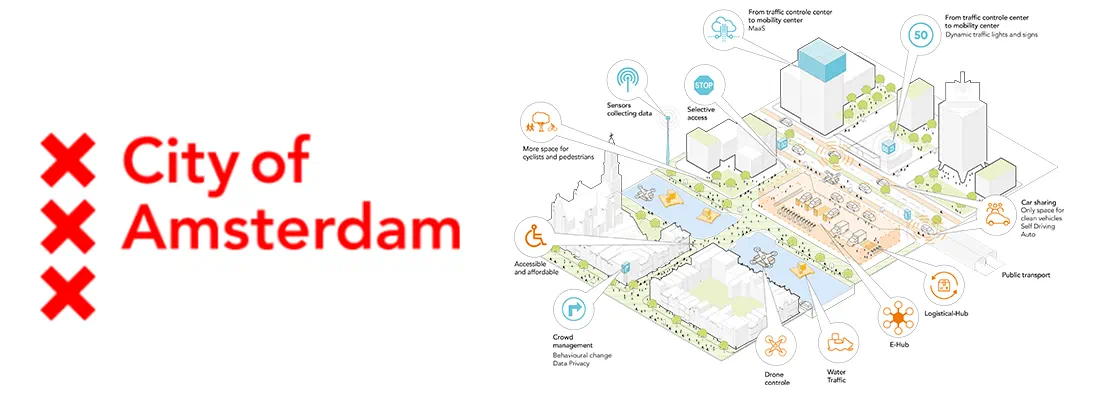During the ADW Industry Update, Building the UAM infrastructure, Lizann Tjon, Program Manager Smart Mobility at City of Amsterdam, talked about how City of Amsterdam is moving towards the No.1 Smart Mobility City. In this interview she shares the most important building blocks.
Can you explain what a Smart Mobility City looks like?
“An accessible, clean and livable city is what we try to achieve. For current residents, visitors and entrepreneurs, but certainly also for future generations. Smarter and cleaner mobility can help us achieve those goals. As a city, we want to offer Amsterdammers, commuters and visitors alternatives to the current forms of mobility. Alternatives that offer a door to door solution and that contribute to our objectives. Think of shared electric mobility, from cars to bicycles, in so-called e-neighborhood hubs that have been set up together with residents. In this way, we move in a clean manner and by sharing we create more space in the city. Space that we can then use to increase the quality of life.
“Not only Amsterdam is developing rapidly, the technology around us is also changing at lightning speed. Digitization plays a major role and various platforms and sub-platforms see opportunities in Amsterdam to offer their services. This offers opportunities but also brings new challenges and issues. Amsterdam anticipates on new developments and does not want to be taken by surprise. In addition, the scarce amount of public space plays a major role. In order to maintain control as a municipality, we are going to impose requirements on market parties that (want to) be active in our public space.”
How will residents and visitors notice this?
“As a municipality, we cannot do this alone in responding to changes and taking control of data. We need the people who live and work here. This requires something from the City as well as from the Amsterdammers themselves. And it requires cooperation. The desired behavioral change can only succeed if there are reliable and flexible mobility solutions for everyone and if different target groups, such as families and the elderly, feel comfortable making different choices than they have done so far.
We do this through various projects:
● Realization of 15 - 20 temporary neighborhood hubs at district level where residents can use electric bicycles, cargo bikes, scooters and cars.
● In the period 2021 - 2022, entice employees at Zuidas to use Mobility as a Service (use public transport, shared transport, plan and pay via 1 app).
● Inform residents and visitors about busy places and give them choices where they can go safely via apps, websites or information boards or hosts on the street via, for example, Crowmanagement.
● Working towards a mobility center of the future by collecting different data sources about pedestrians, cyclists, public transport, Parking to gain more insights into transport flows and crowds in the city.
How do you want to integrate urban air mobility?
“In Amsterdam, we look at different ways of moving to and from the city. This can be done by water, by road, underground and by air. UAM is part of anticipating new mobility concepts. Using the air to be able to move from A to B.”
What are important building blocks and obstacles that should ultimately lead to that number 1 position?
“The building blocks for Amsterdam include testing and experimenting with new solutions to introduce residents, visitors and entrepreneurs to new developments.
But also the ability to scale up initiatives and further explore collaboration opportunities with private parties and knowledge institutions. We do this by working on various projects to have a properly functioning mobility system by 2025.
For example:
● Drawing up Amsterdam principles with clear frameworks and conditions for parties and platforms to share their data with the municipality in order to contribute to a liveable, accessible and accessible city.
● A mobility data platform with various data sources for analysis, monitoring, forecasting and real-time control.
● Work towards a mobility center of the future where Amsterdam has control over various modalities on the street, water and air.
● And stimulating behavioral change by making residents and visitors travel smarter and cleaner.”
Are there plans to conduct field tests with Drone applications?
“Yes on the former Marine site with a sailing drone, but also flying ones. And in the harbour and with the exploration of drone hubs.”
You said that Amsterdam also looks closely at other cities. Which are they and what do you think are good examples?
“Other cities we are looking at include Helsinki for Mobility as a Service, Los Angeles and New York for the control they take over the data and platforms such as taxis and micro-mobility.”
City of Amsterdam and Amsterdam Drone Week
City of Amsterdam is partner of Amsterdam Drone Week. During Amsterdam Drone Week hybrid 2020, 1 - 3 December, the are part of the programme. For more information and ticketing visit: www.amsterdamdroneweek.com.






